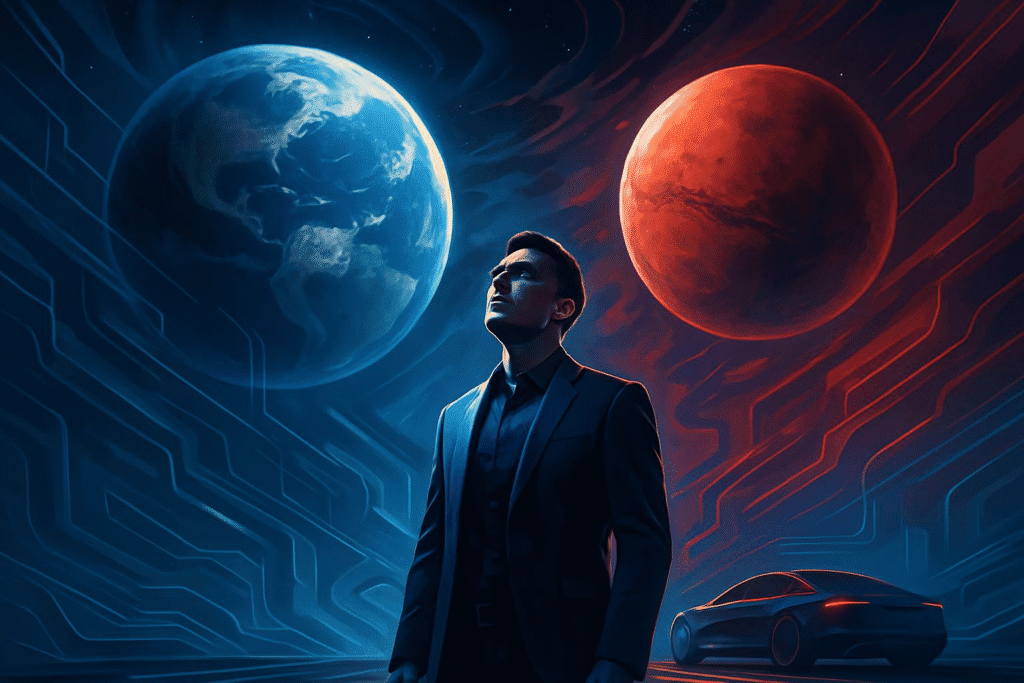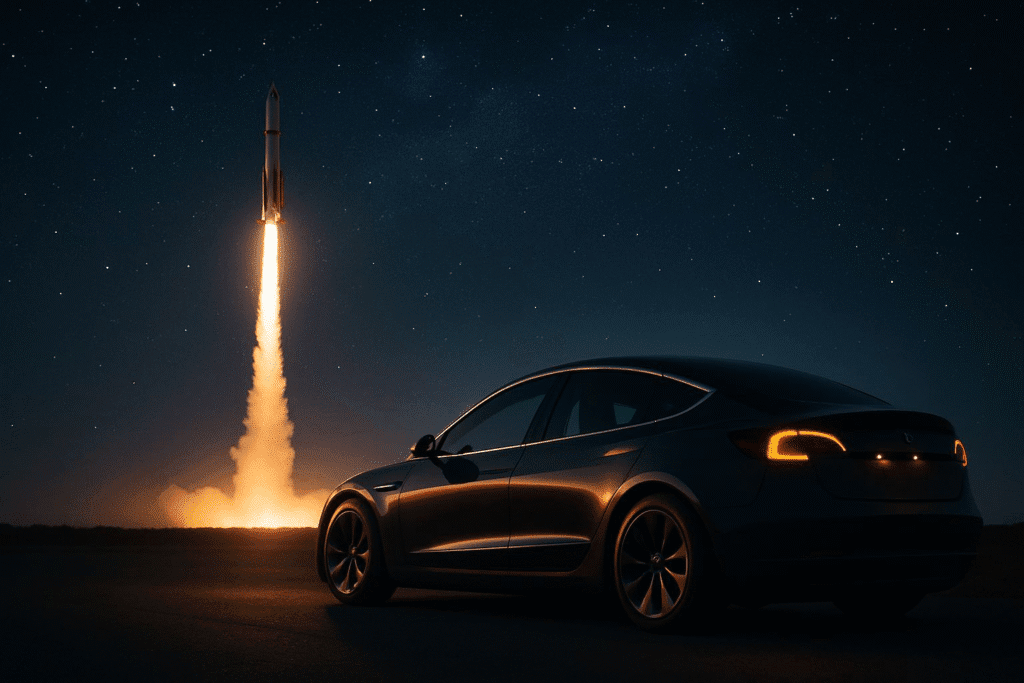Introduction

Imagine arriving in a new country at 17, armed with nothing but a backpack, a suitcase full of books, and a mind brimming with ambition. No wealthy family backing. No Silicon Valley connections. Just raw curiosity and an unshakable belief that you could change the world. That was Elon Musk — long before the headlines, the billions, or the rockets.
Today, Musk is a name synonymous with disruption. He’s not just building electric cars or launching rockets — he’s tearing up the rulebook on how entire industries operate. From redefining online payments to making Mars colonization a serious topic, Musk has reshaped modern life in ways most wouldn’t dare to imagine.
But how did he leap from hustling odd jobs and sleeping in cramped apartments to becoming one of the most influential figures of our century? Was it sheer intelligence, obsession-level work ethic, or just being in the right place at the right time?
In this deep dive, we uncover the lesser-known beginnings of Elon Musk — the struggles, the failures, the brutal decisions — and what truly separates him from the thousands of dreamers who never broke through. If you’re an entrepreneur, creator, or just someone trying to do something that matters, there’s a treasure trove of lessons waiting in his journey.
Before the Billions – The Making of Elon Musk

Every success story has a messy, often overlooked beginning — and Elon Musk’s origin is no exception. Long before launching rockets or flipping the auto industry on its head, Musk was just another kid navigating loneliness, big dreams, and the brutal realities of starting from scratch. But even in his earliest years, the signals were there — the flickers of a mind that wouldn’t settle for average.
A. A Boy Lost in Books, Not the World
Born on June 28, 1971, in Pretoria, South Africa, Elon Musk wasn’t your typical extroverted, sports-playing kid. He was quiet — painfully so — and obsessed with reading. While other kids were out playing, Musk spent his time buried in science fiction, encyclopedias, and computer manuals. By the age of 12, he taught himself programming and developed his first video game, Blastar, which he sold to a magazine for a few hundred bucks. That was his first taste of turning knowledge into value — a taste he’d chase relentlessly for the rest of his life.
But school wasn’t kind to him. Bullied and socially isolated, Musk often felt like an outsider. Yet instead of folding under the pressure, he used solitude as fuel — diving even deeper into learning. That self-taught resilience became his emotional blueprint for taking on impossible challenges later in life.
B. The Leap to Freedom: Escaping South Africa
At 17, Musk made a decision that would change the course of his life forever: he left South Africa, not just to avoid compulsory military service, but to chase a future that felt bigger than the borders of his home country. With barely any money and zero safety net, he landed in Canada — a country where he knew almost no one.
To survive, Musk took on a string of unglamorous jobs — cleaning out boiler rooms, cutting logs, and shoveling grain at a farm. These weren’t resume-builders; they were survival tactics. But every hard day pushed him closer to his goal: getting an education that could launch him into the world of ideas and innovation. He started at Queen’s University in Ontario and later transferred to the University of Pennsylvania — a move that would place him in the orbit of Silicon Valley’s gravitational pull.
C. College Life on a Budget (and a Dream)
At Penn, Musk studied a dual major in physics and economics — not exactly a course load for someone looking to coast through college. But money was tight. He lived in a small, cheap apartment and famously turned it into a makeshift nightclub on weekends, charging entry fees just to cover rent.
Instead of resting over summers, Musk chased internships in cutting-edge tech firms in Silicon Valley, getting early glimpses of the software revolution that was about to reshape the world. Those experiences weren’t just résumé fodder — they were crash courses in entrepreneurial thinking, systems design, and the tech industry’s breakneck pace.
Despite constant financial pressure and personal uncertainty, Musk’s mindset remained unwavering: he wasn’t in it for comfort — he was in it to build the future.
The First Steps Toward Success
Elon Musk’s path to becoming a global tech titan didn’t begin with billion-dollar valuations or media buzz. It started with a series of bold, calculated decisions, a deep belief in the future of technology, and an almost reckless appetite for risk. What set Musk apart wasn’t just his intelligence—it was his absolute refusal to play it safe.
Dropping Out of Stanford: Choosing Vision Over Convention
In 1995, Musk made a decision that would have terrified most people—he dropped out of Stanford University just two days after enrolling in a PhD program. While academia offered prestige and security, Musk saw something bigger on the horizon: the internet. At the time, very few people understood just how transformative the internet would become, but Musk wasn’t interested in waiting for the world to catch up. He believed the digital revolution was happening right now—and he needed to be in the middle of it.
That leap of faith led to the creation of his first startup, Zip2, and marked the beginning of his entrepreneurial story.
Zip2 Corporation: Living in the Office, Building the Future
Musk co-founded Zip2 with his brother Kimbal, building a platform that provided digital maps and business directories for newspapers—a service that foreshadowed modern online tools like Google Maps and Yelp. At a time when most media outlets were still stuck in print, Zip2 offered a way to digitize and monetize local content.
But success didn’t come easy. Musk often worked 20-hour days, slept under his desk, and showered at the local YMCA. He couldn’t afford luxuries—he was too busy turning his vision into reality. The sacrifice paid off when Compaq acquired Zip2 for $307 million in 1999. Musk earned $22 million from the sale, planting the seed money for what would become a pattern in his life: betting big, winning bigger, and never standing still.
X.com and the Birth of PayPal: Rewriting the Rules of Money
Not long after selling Zip2, Musk launched X.com—an online banking platform at a time when people were still skeptical about online payments. His goal wasn’t just to build another bank, but to revolutionize how money moved across the internet. While the company faced internal power struggles and eventually evolved into PayPal through a merger, the core vision stuck: digital payments needed to be fast, simple, and global.
PayPal changed the way the world transacts. In 2002, eBay acquired it for $1.5 billion in stock, and Musk walked away with over $100 million. It would have been easy to retire at that point. But Musk wasn’t in it for the money—he was in it to change the world.
Early Failures and Hard-Earned Lessons
Despite these early wins, Musk’s journey wasn’t without turbulence. He was ousted as CEO from PayPal, often clashed with co-founders, and faced frequent criticism for his management style. But Musk wasn’t discouraged. These experiences shaped him, refining both his vision and his resilience.
Instead of hoarding his wealth, he went all in on his next ventures—investing massive sums into Tesla, SpaceX, and later Neuralink and The Boring Company. Musk understood something most entrepreneurs miss: wealth is not the destination—it’s a tool. He used it to pursue problems that others considered impossible, from colonizing Mars to building a sustainable energy future.
And when things failed—which they often did—Musk didn’t retreat. He adapted. His tolerance for risk, combined with an unshakable long-term vision, turned each failure into a stepping stone for even bigger achievements.
The Billion-Dollar Vision: How Elon Musk Is Engineering the Future of Humanity

Elon Musk is not just a businessman—he’s a force of nature bent on reshaping the world. While most CEOs focus on quarterly earnings and market share, Musk thinks in terms of species survival, planetary colonization, and reprogramming the way humans interact with technology. His ventures are not simply companies; they are vehicles for radical change, aimed at solving some of humanity’s most existential challenges.
Tesla: Electrifying the Auto Industry and Beyond
When Elon Musk invested in Tesla in 2004, the electric vehicle (EV) market was virtually nonexistent. Gas-powered cars ruled the roads, and the idea of a sleek, high-performance EV was considered either a fantasy or a niche novelty. But Musk saw a different future—one where clean energy and cutting-edge engineering could converge to create vehicles that didn’t just match traditional cars but outperformed them.
Tesla’s early days were far from smooth. The company flirted with bankruptcy multiple times. In 2008, with the financial crisis in full swing and the Roadster draining funds, Tesla was weeks away from collapse. Musk put every dollar he had into saving it—at one point even borrowing money from friends for rent. That gamble turned Tesla into a juggernaut. Today, it’s the world’s most valuable car company, a global symbol of innovation, and a driving force behind the shift toward sustainable energy.
The expansion hasn’t slowed. With Gigafactories rising in Mexico and India, Tesla is not only scaling production—it’s embedding itself into the future of transportation across continents.
SpaceX: Making Humanity a Multi-Planetary Species
Musk once said, “I want to die on Mars. Just not on impact.” That sentence encapsulates his boldest ambition: to make humanity an interplanetary species. In 2002, when he founded SpaceX, most saw it as an ego-driven fantasy. But Musk wasn’t looking for headlines—he was looking to rewrite the rules of aerospace.
SpaceX began with the Falcon rockets, but its real innovation was in reusability. Unlike traditional rockets, which burn millions and then crash into the ocean, SpaceX’s designs return to Earth intact and ready for re-launch. This model drastically cuts the cost of space travel and makes missions more frequent and reliable.
The company’s breakthroughs didn’t go unnoticed. NASA, once skeptical, became one of its biggest clients. Today, SpaceX handles ISS resupply missions, sends astronauts into orbit, and is laying the groundwork for deep-space travel. Starship, its most ambitious project, is being designed for Mars colonization—an idea that’s gone from science fiction to strategic planning.
Projections suggest SpaceX will generate over $15.5 billion in revenue by 2025—surpassing NASA’s entire annual budget. Musk isn’t just competing with legacy space agencies—he’s redefining their relevance.
Beyond Cars and Rockets: The Ecosystem of Innovation
While Tesla and SpaceX dominate headlines, Musk’s portfolio extends into other mind-bending frontiers. With Neuralink, he’s exploring how humans can merge with AI by developing brain-computer interfaces. The goal? To treat neurological conditions—and eventually, enhance cognition itself. It’s a controversial field, but Musk’s team has already made progress in implanting chips that allow test animals to interact with machines using only thought.
The Boring Company, another of Musk’s ventures, aims to solve traffic congestion by building high-speed underground transport tunnels. Critics scoffed at the idea, but pilot projects like the Las Vegas Convention Center Loop are already operational and expanding.
In 2022, Musk added another high-stakes chapter to his story by acquiring Twitter, rebranding it as X. His vision for the platform extends beyond social media—he sees it evolving into an “everything app,” combining communication, finance, and AI-powered services under one roof. While the move sparked intense debate, it showcased a consistent theme in Musk’s playbook: challenge the status quo, even if it means making enemies.
Together, these ventures don’t just make up a business empire—they form an interconnected vision of the future. A future powered by clean energy, governed by ethical AI, enhanced through brain-machine synergy, and potentially lived on more than one planet.
Lessons from Musk’s Success: What Entrepreneurs Can Learn from the World’s Boldest Visionary

Elon Musk’s journey from a curious teenager in South Africa to a globally recognized tech magnate is not just inspirational—it’s instructional. Beneath the headlines and hype are core principles and behaviors that entrepreneurs, leaders, and innovators can learn from. Musk doesn’t operate by luck or coincidence. His success is deeply rooted in a set of strategies and mindsets that consistently defy norms and produce results.
1. Relentless Focus on Solving Difficult Problems
Musk doesn’t build companies for short-term wins or vanity metrics. He identifies the most pressing challenges facing humanity—climate change, multi-planetary existence, sustainable transportation—and sets out to solve them. Whether it’s accelerating the world’s transition to electric vehicles with Tesla or making space travel viable with SpaceX, his focus is always on high-stakes, high-impact problems. This commitment to purpose, not just profit, is what makes his ventures stand out—and what keeps attracting top talent and loyal customers.
2. First Principles Thinking: Rebuilding the Rules
While many entrepreneurs rely on analogies or industry standards to make decisions, Musk applies a method rooted in physics: first principles thinking. He breaks down complex problems into their most basic components and reconstructs solutions from the ground up. For example, when he realized rockets were overpriced not because of the materials but due to outdated design and wasteful manufacturing, he created SpaceX to rebuild them from scratch—at a fraction of the cost.
This same method helped Tesla rethink battery technology and production scaling. The lesson? Don’t accept limitations just because they’re “how things are done.” Start with the facts, question assumptions, and build from zero.
3. Embracing Failure as a Catalyst for Growth
Failure is not a detour in Musk’s journey—it’s a core part of the process. SpaceX saw three failed rocket launches before its first successful orbit. Tesla teetered on the edge of financial ruin. Even his public ventures like Twitter/X have brought backlash and scrutiny. But Musk never lets failure become final. He views it as feedback, adapts quickly, and keeps moving forward.
In a world that often fears mistakes, Musk turns them into fuel. His resilience in the face of criticism and chaos is a masterclass in emotional discipline and long-term thinking.
4. Innovation Grounded in User Experience
While Musk is known for pushing boundaries, he never loses sight of the user. Every product he builds—from Tesla’s minimalist dashboards to SpaceX’s crew capsules—is designed to be not just functional, but delightful. Even Neuralink, a venture on the frontier of brain-computer interaction, focuses on real human benefits like treating neurological disorders before reaching for science-fiction ideals.
This customer-first approach is a powerful lesson: innovation is only meaningful if it solves real problems in ways people value and want to use.
5. Decisive Action and Strategic Agility
In today’s fast-changing world, over-analysis can be deadly. Musk thrives on speed. He makes decisions quickly, adjusts course when needed, and isn’t afraid to scrap entire models if they no longer serve the mission. When Tesla faced production bottlenecks, Musk famously slept in the factory and restructured the process in real-time. When Twitter/X needed a new business direction, he didn’t hesitate to implement controversial yet bold changes.
Musk’s adaptability ensures his companies remain dynamic and ahead of the curve—something every startup founder and business leader should take seriously.
These principles aren’t exclusive to Elon Musk. They’re available to anyone willing to think bigger, move faster, and take risks that matter. Whether you’re launching a startup or leading a team, applying just a few of Musk’s strategies can help transform not just your career—but your entire perspective on what’s possible.
Recommended Reads: Dive Deeper into Elon Musk’s World
If Elon Musk’s journey fascinates you and you’re eager to understand what drives his vision, mindset, and disruption of entire industries, these highly-rated books are essential additions to your reading list. Each offers unique insights—from behind-the-scenes business moves to personal reflections and the pivotal moments that shaped his career.
1. Elon Musk by Walter Isaacson
- Why You Should Read It: Written by the biographer of Steve Jobs, this in-depth portrait reveals the complexities of Musk’s personality, leadership style, and unrelenting drive. Isaacson follows Musk through his daily routines, decisions, and dilemmas, offering a front-row view into one of the most influential minds of our time.
- 🛒 Get it on Amazon: Buy here
2. Elon Musk: Tesla, SpaceX, and the Quest for a Fantastic Future by Ashlee Vance
- Why You Should Read It: A comprehensive narrative that explores Musk’s early failures, ambitious goals, and how he built Tesla and SpaceX into powerhouse companies. Vance blends biography with business analysis, making it an inspiring read for aspiring entrepreneurs and innovators.
- 🛒 Get it on Amazon: Buy here
3. Liftoff: Elon Musk and the Desperate Early Days That Launched SpaceX by Eric Berger
- Why You Should Read It: Focused solely on SpaceX, this gripping book captures the chaos, near-death moments, and breakthroughs that defined its early years. Perfect for readers curious about what it really takes to launch a private space company from scratch.
- 🛒 Get it on Amazon: Buy here
💡 Pro Tip for Readers
Consider using Amazon’s “Look Inside” feature to preview chapters before purchasing. You’ll often find golden insights in the first few pages that hook you immediately.
Conclusion
Elon Musk’s transformation from a teenage immigrant with just $2,000 in his pocket to the richest man in the world isn’t just a success story—it’s a blueprint for radical thinking, fearless execution, and unrelenting persistence.
What makes Musk stand out isn’t just the size of his fortune, but the scale of his ambition. From disrupting the automotive industry to redefining space travel, he continues to challenge what’s possible—and in doing so, forces the rest of the world to level up.
Here are some powerful takeaways from his journey:
✅ Big dreams require bold action – Musk didn’t wait for opportunity to knock; he built the door himself.
✅ Failure isn’t fatal – Tesla faced near-bankruptcy. SpaceX rockets exploded. Still, he pushed forward—again and again.
✅ Innovation leads progress – Whether it’s EVs, Mars colonization, or brain-computer interfaces, Musk keeps building for the future.
✅ Work ethic matters more than talent alone – Sleeping in factories and working 80+ hour weeks, Musk walks the talk.
Despite controversy and setbacks, Elon Musk remains one of the most influential—and polarizing—figures of our time. His story reminds us that no goal is too large if you’re willing to think differently, fail publicly, and work tirelessly.
🚀 Want more deep dives like this one?
Explore more insightful breakdowns of game-changing innovators and disruptive ideas at 👉 inkinsight.in
FAQ’s
Did Elon Musk really arrive in North America with only $2,000?
Yes. At just 17 years old, Musk left South Africa and moved to Canada with $2,000, a backpack, and a suitcase full of books. His goal was to find greater opportunities in North America—and that journey laid the groundwork for his entrepreneurial future.
How did Elon Musk afford college?
Musk supported himself by working odd jobs, including shoveling grain, cleaning boilers, and even working on farms. He started his studies at Queen’s University in Ontario and later transferred to the University of Pennsylvania, where he earned degrees in economics and physics.
What was Elon Musk’s first major business success?
His first major success was Zip2, a company he co-founded with his brother Kimbal. Zip2 helped newspapers create online city guides and business directories. In 1999, Compaq acquired Zip2 for $307 million, giving Musk his first multimillion-dollar exit.
Why did Elon Musk drop out of Stanford University?
After being accepted into a PhD program at Stanford, Musk dropped out just two days later. He believed the internet boom was the opportunity of a lifetime and wanted to dive into entrepreneurship immediately—leading to the creation of Zip2.
What industries has Elon Musk disrupted?
Musk has left his mark on several major industries:
Electric vehicles through Tesla
Space exploration through SpaceX
Artificial intelligence with Neuralink
Urban transportation via The Boring Company
Social media through his acquisition and rebranding of Twitter/X
